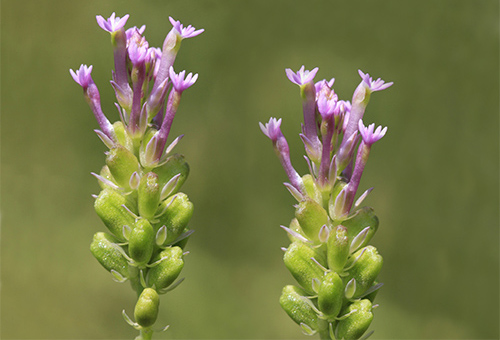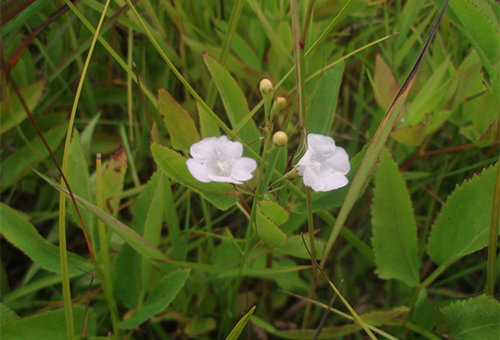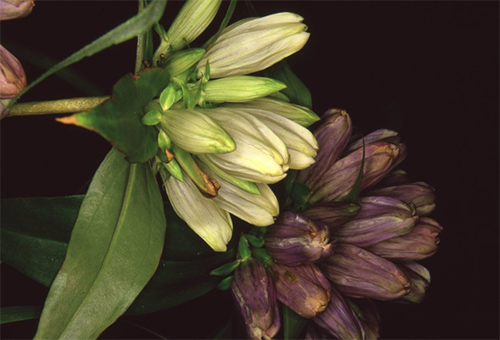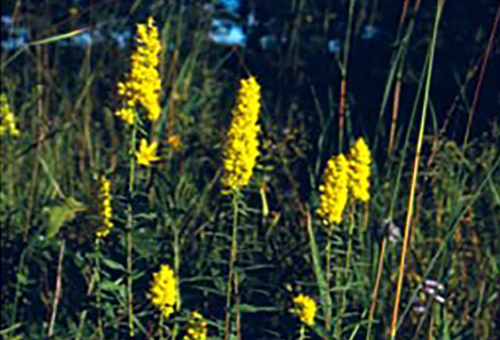Pink Milkwort, Showy Goldenrod (Great Lakes Plains population), Skinner’s Agalinis, and White Prairie Gentian

Photo credit: © Tom Preney CC BY-NC 4.0

Photo credit: © Graham Buck CC BY-NC 4.0

Photo credit: © Michael Oldham CC BY-NC 4.0

Photo credit: Gary Allen
Species information
The following is a report on progress made towards the protection and recovery of Pink Milkwort (Polygata incarnata), Showy Goldenrod (Great Lakes Plains population; Solidago speciosa), Skinner’s Agalinis (Agalinis skinneriana), and White Prairie Gentian (Gentiana alba) in Ontario from 2007 to 2020, based on Ontario’s species-specific recovery policy. This report meets the legislative requirement for a review of progress under the Endangered Species Act, 2007 (ESA or “the Act”). Pink Milkwort, Showy Goldenrod (Great Lakes Plains population), Skinner’s Agalinis, and White Prairie Gentian are listed as endangered on the Species at Risk in Ontario (SARO) List under the ESA.
Pink Milkwort, Skinner’s Agalinis, and White Prairie Gentian were listed as endangered species under the ESA when the Act came into force in June 2008. Showy Goldenrod (Great Lakes Plains population) was listed as an endangered species under the ESA on June 8, 2011.
Pink Milkwort, Skinner’s Agalinis, and White Prairie Gentian have been protected from being killed, harmed, harassed, captured or taken since 2008. Showy Goldenrod (Great Lakes Plains population) has been protected from being killed, harmed, harassed, captured or taken since 2011.
In addition, the habitat of Pink Milkwort and Skinner’s Agalinis has been protected from being damaged or destroyed since 2008. The habitat of Showy Goldenrod (Great Lakes Plains population) has been protected from being damaged or destroyed since 2011. The habitat of White Prairie Gentian has been protected from being damaged or destroyed since 2013.
The species-specific recovery policy for Pink Milkwort, Showy Goldenrod (Great Lakes Plains population), Skinner’s Agalinis, and White Prairie Gentian, known as the Government Response Statement (GRS) was published in 2016 and includes the government’s recovery goal for the species and the actions and priorities it intends to lead or support to help achieve that goal. The GRS considers science advice provided in the recovery strategy (Pink Milkwort Recovery Strategy, Showy Goldenrod (Great Lakes Plains population) Recovery Strategy, Skinner’s Agalinis Recovery Strategy, and White Prairie Gentian Recovery Strategy), when developing recovery actions for the species. As legislated in the Act, the purpose of this review is to report on progress made towards implementing the protection and recovery actions in the GRS. The review can also help identify opportunities to adjust and adapt the implementation of protection and recovery actions to achieve the recovery goal for the species.
Pink Milkwort
Showy Goldenrod (Great Lakes Plains population)
Skinner's Agalinis
White Prairie Gentian
Further information about Pink Milkwort, Showy Goldenrod (Great Lakes Plains population), Skinner’s Agalinis, and White Prairie Gentian, including the threats that they face, and actions being taken to help protect and recover these species is available on the Government of Ontario webpages for Pink Milkwort, Showy Goldenrod (Great Lakes Plains population), Skinner’s Agalinis, and White Prairie Gentian. A summary on the progress towards the protection and recovery of Pink Milkwort, Showy Goldenrod (Great Lakes Plains population), Skinner’s Agalinis, and White Prairie Gentian and an annual update on the broader species at risk program (i.e. the Introduction to the 2021 Review of Progress report) is available on the Review of Progress towards the Protection and Recovery of Ontario’s Species at Risk webpage.
Snapshot: Progress towards the protection and recovery of Pink Milkwort, Showy Goldenrod (Great Lakes Plains population), Skinner’s Agalinis, and White Prairie Gentian
Progress towards meeting the recovery goal
- The recovery goal in the Government Response Statement (GRS) for Pink Milkwort, Showy Goldenrod (Great Lakes Plains population), Skinner’s Agalinis, and White Prairie Gentian in Ontario is to “maintain current population levels of the species in Ontario, to maintain the presence of the species at locations where they occur, and where feasible, enable natural increases in abundance of the species by reducing threats to the species and their habitat. The government supports investigating the feasibility of augmenting the existing populations of White Prairie Gentian and Pink Milkwort at appropriate locations”.
- Progress has been made towards implementing all government-led actions. Progress has been made towards implementing all of the government-supported recovery objectives and a majority of the associated actions. Examples of progress include:
- education and outreach on the importance of grasslands for species at risk, including Pink Milkwort, Showy Goldenrod (Great Lakes Plains population), Skinner’s agalinis, and White Prairie Gentian
- grassland restoration and management activities that included the removal of invasive species
- the development of prescribed burn guidelines for Bkejwanong (Walpole Island First Nation)
- In alignment with the GRS, more work is needed to implement a standardized long-term monitoring program, conduct surveys at all historic locations, secure additional habitat and conduct further research on these species.
Occurrences and distribution
- Pink Milkwort, Showy Goldenrod (Great Lakes Plains population), Skinner’s Agalinis, and White Prairie Gentian occur in a small number of geographically-isolated populations
footnote 1 in southwestern Ontario prairies, and in some cases, savannas and alvars. - Pink Milkwort occurrence summary:
- This species has a distribution of three square kilometres based on recent observations, and an additional eight square kilometres of historical habitat.
- The Natural Heritage Information Centre (NHIC) has received 30 records of the species based on observations made between 1823 and 2017.
- Since 2008, the species has been re-confirmed in three locations. Pink Milkwort has not been observed in any new locations.
- Showy Goldenrod (Great Lakes Plains population) occurrence summary:
- This species has a distribution of 12 square kilometres based on recent observations, and an additional 20 square kilometres of historical habitat.
- NHIC has received 26 records of the species based on observations made between 1910 and 2008.
- Since 2008, the species has been re-confirmed in eight locations. Showy Goldenrod (Great Lakes Plains population) has not been observed in any new locations.
- Skinner’s Agalinis occurrence summary:
- This species has a distribution of two square kilometres based on recent observations, and an additional seven square kilometres of historical habitat.
- NHIC has received 20 records of the species based on observations made between 1958 and 2009.
- Since 2008, the species has been re-confirmed in two locations. Skinner’s Agalinis has not been observed in any new locations.
- White Prairie Gentian occurrence summary:
- This species has a distribution of 24 square kilometres based on recent observations
footnote 2 , and an additional two square kilometres of historical habitat. - NHIC has received 14 records of the species based on observations made between 1840 and 2019.
- Since 2008, the species has been observed in one location where it was not previously known to occur. Based on up-to-date information, the species’ extant distribution is estimated to encompass an area one square kilometre larger than was known since the ESA came into effect. The species has also been re-confirmed in two locations.
- This species has a distribution of 24 square kilometres based on recent observations
Government-supported stewardship projects
- Through the Species at Risk Stewardship Program, the Government of Ontario has enabled its stewardship partners to conduct 18 projects (by providing $645,909 in funding) that have supported the protection and recovery of multiple species at risk, including Pink Milkwort, Showy Goldenrod (Great Lakes Plains population), Skinner’s Agalinis, and White Prairie Gentian.
- The government’s support helped its stewardship partners to involve 255 individuals who volunteered 5,118 hours of their time towards protection and recovery activities for species at risk, including Pink Milkwort, Showy Goldenrod (Great Lakes Plains population), Skinner’s Agalinis, and White Prairie Gentian. The estimated value of these voluntary contributions, as well as additional funding and in-kind support, is $1,387,713.
- Stewardship partners reported that through their actions 89 hectares of habitat were enhanced for Pink Milkwort, Showy Goldenrod (Great Lakes Plains population), Skinner’s Agalinis, and/or White Prairie Gentian and other species at risk that inhabit the same ecosystem.
- Stewardship partners reported providing outreach on multiple species at risk, including Pink Milkwort, Showy Goldenrod (Great Lakes Plains population), Skinner’s Agalinis, and White Prairie Gentian, to 5,829 individuals.
- Through the Species at Risk Research Fund for Ontario, the Government of Ontario supported one research partner to develop a method to detect plant species at risk in Ontario.
Supporting human activities while ensuring appropriate support for species recovery
- One agreement was entered into for Showy Goldenrod (Great Lakes Plains population). This agreement was enabled through Ontario Regulation 242/08 (prior to the July 1, 2013 amendment).
- 10 activities have been registered for these species. The activities were registered under ‘Drainage works’ (section 23.9), ‘Species protection, recovery activities’ (section 23.17), and ‘Threats to health and safety, not imminent’ (section 23.18), under Ontario Regulation 242/08 of the ESA.
Reporting on the progress towards the protection and recovery of Pink Milkwort, Showy Goldenrod (Great Lakes Plains population), Skinner’s Agalinis, and White Prairie Gentian
Recovery goal
The government’s goal for the recovery of Pink Milkwort, Showy Goldenrod (Great Lakes Plains population), Skinner’s Agalinis, and White Prairie Gentian is to maintain current population levels of the species in Ontario, to maintain the presence of the species at locations where they occur, and where feasible, enable natural increases in abundance of the species by reducing threats to the species and their habitat. The government supports investigating the feasibility of augmenting the existing populations of White Prairie Gentian and Pink Milkwort at appropriate locations.
The implementation of government-led and government-supported actions demonstrates progress towards reaching the desired objectives and the recovery goal set out in the GRS.
Progress towards implementing government-led actions
Progress has been made towards implementing all government-led actions identified in the GRS. Common actions for the government to lead as it works towards achieving a species’ recovery goal include:
- Co-operate with federal partners, such as Environment and Climate Change Canada, to implement protection and recovery actions, where appropriate.
- Educate other agencies and authorities involved in planning and environmental assessment processes on the protection requirements under the ESA.
- Encourage the submission of Pink Milkwort, Showy Goldenrod (Great Lakes Plains population), Skinner’s Agalinis, and White Prairie Gentian data to the Government of Ontario’s central repository at the Natural Heritage Information Centre (NHIC).
- Undertake communications and outreach to increase public awareness of species at risk in Ontario.
- Protect the Pink Milkwort, Showy Goldenrod (Great Lakes Plains population), Skinner’s Agalinis, and White Prairie Gentian and their habitat through the ESA.
- Develop direction to provide greater clarity to proponents and partners on the areas of general habitat protected under the ESA for plant species at risk.
- Support conservation, agency, municipal and industry partners, and Indigenous communities and organizations to undertake activities to protect and recover the Pink Milkwort, Showy Goldenrod (Great Lakes Plains population), Skinner’s Agalinis, and White Prairie Gentian. Support will be provided where appropriate through funding, agreements, permits (including conditions) and/or advisory services.
- Encourage collaboration and establish and communicate annual priority actions for government support in order to reduce duplication of efforts.
Additionally, the government has directly undertaken the following species-specific actions:
- Continue to manage the habitat of Pink Milkwort in Ojibway Prairie Provincial Nature Reserve to maintain the ecological integrity of its habitat and to minimize the threat of recreational pressures and impacts.
- Continue to implement the Ontario Invasive Species Strategic Plan to address the invasive species (e.g., Phragmites (Phragmites australis ssp. australis), Black Locust (Robinia pseudoacacia), White Sweet Clover (Melilotus albus), and Canada Thistle (Cirsium arvense) that threaten Pink Milkwort, Showy Goldenrod (Great Lakes Plains population), Skinner’s Agalinis, and White Prairie Gentian.
Ontario Parks conducts prescribed burning and invasive species management to contribute to the recovery of species at risk, including Pink Milkwort, at Ojibway Prairie Provincial Nature Reserve in partnership with Wildlife Preservation Canada and the City of Windsor.
Key progress made towards implementing these actions is described in the following sections.
Ontario’s Invasive Species Act
The GRS for Pink Milkwort, Showy Goldenrod (Great Lakes Plains population), Skinner’s Agalinis, and White Prairie Gentian indicates that invasive species (e.g. Phragmites) pose a threat to the survival and recovery of the species in Ontario. The Ontario Invasive Species Strategic Plan, 2012 and the Invasive Species Act, 2015 provide the policy and legislative framework to prevent new invaders from arriving and surviving in Ontario; to slow and where possible reverse the spread of existing invasive species, and to reduce the harmful impacts of existing invasive species, including impacts on species at risk. This framework may support the implementation of actions to reduce the threats from invasive species.
Guides and resources
The Species at Risk Farm Incentive Program and Grasslands Stewardship Initiative provide funding and guidance to farmers and landowners for enhancing, maintaining, and creating habitat for species at risk, including grasslands. These initiatives may benefit one or more species at risk, including Pink Milkwort, Showy Goldenrod (Great Lakes Plains population), Skinner’s Agalinis, and White Prairie Gentian.
Occurrences and distribution
Pink Milkwort, Showy Goldenrod (Great Lakes Plains population), Skinner’s Agalinis, and White Prairie Gentian occur in a small number of geographically-isolated populations in southwestern Ontario, mainly on Walpole Island on the St. Clair River delta. Outside of Walpole Island, there is a Pink Milkwort population at the Ojibway Prairie Provincial Nature Reserve in Windsor-LaSalle, Ontario, and White Prairie Gentian has recently been observed in Lambton, Ontario. All four species occur in prairies that range in moisture condition from wet-mesic to dry and occur in open conditions. Additionally, White Prairie Gentian may be found in savannas and alvars, and Showy Goldenrod (Great Lakes Plains population) occurs in Black Oak savannas. For this review of progress, species’ occurrence information has been assessed at a landscape scale using one by one kilometre grid “squares” to approximate species’ distribution. The squares were used to estimate where these species have been recently observed (i.e., within the past 20 years) as well as squares where these species are considered historical
Pink Milkwort
Using this approach, Pink Milkwort has been recently observed in three squares, two of which also have historical observations. There are eight squares with strictly historical observations of the species. This equates to a potential range of approximately three square kilometres based on recent observations of the species, and an additional eight square kilometres based on historical observations. Additionally, there is one observation record from 1823, located near Niagara Falls; however, there is no information available on the extent of this record (i.e. number of grid squares it covers) and no further observations have occurred in this location.
The NHIC has received 30 records of Pink Milkwort. The records are based on observations between 1823 and 2017. Based on records since 2008, the species’ presence has been re-confirmed in three squares, but has not been located in any new squares.
Showy Goldenrod (Great Lakes Plains population)
Using the approach described above, Showy Goldenrod (Great Lakes Plains population) has been recently observed in 12 squares (since 2001), nine of which also have historical observations. There are 20 squares with strictly historical observations of the species. This equates to a potential range of approximately 12 square kilometres based on recent observations of the species and an additional 20 square kilometres of historical habitat. Additionally, there are three observation records from more than 50 years ago on Walpole Island First Nation, with more recent observations occurring in the area. The NHIC has received 26 records of Showy Goldenrod. The records are based on observations between 1910 and 2008. The most recent records from 2008 re-confirmed the species’ presence in eight squares. No new locations have been found.
Skinner’s Agalinis
Using the approach described above, Skinner’s Agalinis has been recently observed in two squares, both of which also have historical observations. There are seven squares with strictly historical observations of the species. This equates to a potential range of approximately two square kilometres based on recent observations of the species and an additional seven square kilometres of historical habitat. Interestingly, there is one observation record from more than 50 years ago that occurs within the two recently observed grid squares.
The NHIC has received 20 records of Skinner’s Agalinis. The records are based on observations between 1958 and 2009. Based on records since 2008, the species’ presence has been re-confirmed in two squares, and no new locations have been found.
White Prairie Gentian
Using the approach described above, White Prairie Gentian has been recently observed in 24 squares, two of which also have historical observations. There are two squares with strictly historical observations of the species. This equates to a potential range of approximately 24 square kilometres
The NHIC has received 14 records of White Prairie Gentian. The records are based on observations between 1840 and 2019. Based on records since 2008, the species has been identified in one new square in Lambton County and re-confirmed in two squares on Walpole Island. Additional squares described above reflect imprecise location data for three records. This enlargement of the species’ estimated distribution by one square kilometre is most likely the result of increased search effort and education about White Prairie Gentian and represents increased knowledge on the distribution of the species. Efforts to engage citizen scientists in collecting data for these species have increased since 2012, with an assortment of programs and tools available for observations to be submitted and confirmed.
Encouraging the submission of observations of these species is included in the GRS as a government-led action. Submission of species observations increases our knowledge of where they occur and can play an important role in assessing the viability of species’ populations.
Everyone is encouraged, or may be required by an authorization or approval, to submit observations of Pink Milkwort, Showy Goldenrod (Great Lakes Plains population), Skinner’s Agalinis, and White Prairie Gentian, and any other species at risk, to the NHIC for incorporation into the provincial record of observations. Observations may now be submitted to NHIC via the Rare Species of Ontario project in iNaturalist.
-
3observations of Pink Milkwort were submitted to the NHIC since 2008
-
2observations of Showy Goldenrod (Great Lakes Plains population) were submitted to the NHIC since 2008
-
2observations of Skinner's Agalinis were submitted to the NHIC since 2008
-
2observations of White Prairie Gentian were submitted to the NHIC since 2008
Government-supported stewardship projects
An important government-led action in the GRS for Pink Milkwort, Showy Goldenrod (Great Lakes Plains population), Skinner’s Agalinis, and White Prairie Gentian is to support partners to undertake activities to protect and recover the species. Through the Species at Risk Stewardship Program the government has supported 18 projects ($645,909) designed to contribute to the protection and recovery of Pink Milkwort, Showy Goldenrod (Great Lakes Plains population), Skinner’s Agalinis, and White Prairie Gentian. All projects focused on multiple species at risk and included one or more of these species. In addition to the government funding, partners were successful in securing additional funding ($1,387,713) from other sources. These amounts include in-kind support in the form of time and expertise provided by volunteers.
Stewardship partners reported that provincial funding helped them to secure in-kind support by involving 255 individuals who volunteered 5,118 hours of their time towards protection and recovery activities for multiple species at risk, including Pink Milkwort, Showy Goldenrod (Great Lakes Plains population), Skinner’s Agalinis, and White Prairie Gentian, which has an estimated value of $202,135. Partners also reported that through both their efforts and the efforts of their volunteers to implement GRS actions, they were successful in enhancing 89 hectares of habitat that will benefit multiple species at risk, including the species described here. In addition, stewardship partners reported providing ecosystem-based outreach on multiple species, including Pink Milkwort, Showy Goldenrod (Great Lakes Plains population), Skinner’s Agalinis, and White Prairie Gentian, to 5,829 individuals.
The government also supports proponents in conducting research that addresses important knowledge gaps for species at risk. Through the Species at Risk Research Fund for Ontario, the government provided funding to a partner to conduct research on a detection method for cryptic plant species at risk in Ontario.
The remainder of this section highlights three projects supported through the Species at Risk Stewardship Program as well as the corresponding government-supported recovery actions for the species.
Species at risk recovery efforts on Walpole Island
The Walpole Island Heritage Centre (WIHC) has made significant efforts to raise awareness and support the recovery of grassland species at risk on Walpole Island, including Pink Milkwort, Showy Goldenrod (Great Lakes Plains population), Skinner’s Agalinis, and White Prairie Gentian.
Between 2007 and 2008, WIHC developed several documents to guide protection and recovery efforts for species at risk on Walpole Island. These included a species at risk curriculum for elementary school students, a youth stewardship program plan, a species at risk communications and outreach strategy, and a plan and guidelines for prescribed burning on Bkejwanong (Walpole Island First Nation). Traditional Knowledge was weaved into each of these materials. This project supported the implementation of actions 3, 4, 5 and 9 in the GRS.
From 2010 to 2011, WIHC provided extensive training to Bkejwanong youth on identifying, monitoring and managing species at risk and their habitats through the Bkejwanong Eco-Keepers program. Traditional Knowledge was weaved into training and activities which included prairie plant and invasive species identification training, an introduction to field data collection methods, maintaining an interpretive prairie garden and habitat enhancement through the removal of the non-native, invasive White Sweet Clover. In addition, project staff prepared and presented several communications and outreach materials to inform the community about this program and species at risk on Walpole Island. This project was supported by Ontario’s Species at Risk Stewardship Program, Bkejwanong, and over two dozen organizations, community groups, individuals and volunteers. It supported the implementation of actions 3, 4 and 9 in the GRS.
In 2015 and 2016, WIHC worked with community members and consultants to develop habitat management plans for three species at risk on Walpole Island, including a plan for White Prairie Gentian that assesses the feasibility of increasing the population size and reproductive capacity of this species. Once these plans were completed, project staff and volunteers began to implement recommended activities such as monitoring and removing invasive species and educating the community about species at risk on Walpole Island. This resulted in the removal of encroaching woody vegetation at targeted species at risk habitat sites and direct engagement with hundreds of community members. This project was supported by Ontario’s Species at Risk Stewardship Program, Canada’s Aboriginal Fund for Species at Risk program, and several Walpole Island community groups, schools, and volunteers. It supported the implementation of actions 1, 4, 6 and 9 in the GRS.
Species at Risk Stewardship Program
-
 18
18projects included Pink Milkwort, Showy Goldenrod (Great Lakes Plains population), Skinner's Agalinis and White Prairie Gentian
-
 $645,909
$645,909for multi-species projects that included Pink Milkwort, Showy Goldenrod (Great Lakes Plains population), Skinner's Agalinis and White Prairie Gentian
-
 $1,387,713
$1,387,713in additional funding and in-kind support
-
 255
255volunteers
-
 5,118
5,118volunteer hours
-
 5,829
5,829people received outreach
-
 89
89hectares of habitat enhanced
Supporting human activities while ensuring appropriate support for species recovery
Supporting partners through authorizations and their associated conditions is an important government-led action. To date, no permits have been issued for Pink Milkwort, Showy Goldenrod (Great Lakes Plains population), Skinner’s Agalinis, or White Prairie Gentian.
One agreement was entered into for Showy Goldenrod (Great Lakes Plains population). This agreement was enabled through Ontario Regulation 242/08 (prior to the July 1, 2013 amendment). Conditions of the agreements involve implementing actions in the mitigation plan, including, but not limited to:
- monitoring and reporting on implementation of mitigation measures
- reporting sightings of Showy Goldenrod (Great Lakes Plains population) to the NHIC
- provide measures to minimize disturbance to trees and herbaceous plants (e.g. identifying and marking individuals, buffer area, avoiding compaction of soil)
Since 2013:
- Three activities that may affect Pink Milkwort or its habitat have been registered for the purposes of Ontario Regulation 242/08 under the ESA. All activities were registered under ‘Threats to health and safety, not imminent’ (section 23.18).
- Three activities that may affect Showy Goldenrod (Great Lakes Plains population) or its habitat have been registered for the purposes of Ontario Regulation 242/08 under the ESA. Two activities were registered under ‘Drainage works’ (section 23.9) and one was registered under ‘Threats to health and safety, not imminent’ (section 23.18).
- Two activities that may affect Skinner’s Agalinis or its habitat have been registered for the purposes of Ontario Regulation 242/08 under the ESA. One activity was registered under ‘Threats to health and safety, not imminent’ (section 23.18) and one was registered under ‘Species protection, recovery activities’ (section 23.17).
- Two activities that may affect White Prairie Gentian or its habitat have been registered for the purposes of Ontario Regulation 242/08 under the ESA. One activity was registered under ‘Threats to health and safety, not imminent’ (section 23.18) and one was registered under ‘Drainage works’ (section 23.9).
These registrations require the registrant to comply with all conditions of the regulation, such as:
- preparing a mitigation plan using the best available information on steps that may help minimize or avoid adverse effects on the species
- reporting species observations using the Ontario Species at Risk Observation Reporting Form, and submitting them to the NHIC
- relocating vascular plants to a nearby location within the species’ habitat that is suitable and safe for the species, so it is not killed or harmed, if it is feasible to do so
-
1agreement
-
10registrations
Progress towards implementing government-supported actions
Government-supported actions are organized under overarching recovery objectives. Progress has been made towards achieving all government-supported recovery objectives and implementing the majority of the associated actions identified in the GRS for Pink Milkwort, Showy Goldenrod (Great Lakes Plains population), Skinner’s Agalinis, and White Prairie Gentian.
Objective: Enhance knowledge of Pink Milkwort, Showy Goldenrod (Great Lakes Plains population), Skinner’s Agalinis, and White Prairie Gentian distribution, abundance and Traditional Ecological Knowledge in Ontario.
- Action No. 1 (High Priority) – Develop and implement a standardized long-term monitoring program at locations where Pink Milkwort, Showy Goldenrod (Great Lakes Plains population), Skinner’s Agalinis, and/or White Prairie Gentian occur. As appropriate, the monitoring program should target multiple species at risk plants that occur in the same locations (e.g., Dense Blazing Star (Liatris spicata)). The monitoring program will aim to:
- monitor population trends, demographics, reproductive success and habitat conditions
- assess and monitor all known threats and potential threats to populations
- Action No. 2 (High Priority) – Conduct surveys to confirm the presence or absence of Pink Milkwort, Showy Goldenrod (Great Lakes Plains population), Skinner’s Agalinis, and/or White Prairie Gentian populations at suitable habitat in historic locations and locations where the continued presence of the species are unknown; and
- Action No. 3 – Encourage the recording, sharing and transfer of Traditional Ecological Knowledge on Pink Milkwort, Showy Goldenrod (Great Lakes Plains population), Skinner’s Agalinis, and White Prairie Gentian including information on the historical distribution of the species and their habitat to support a local ecosystem approach to managing species at risk. Coordinate the collection of Traditional Ecological Knowledge on other species at risk which occur in the same ecosystem (e.g., Small White Lady’s-slipper and Dense Blazing Star).
Under this objective, initial progress has been made towards implementing Action No. 1. Progress has been made towards implementing Action No. 2 and 3.
Initial progress has been made towards implementing Action No. 1 through two Species at Risk Stewardship Program projects. The first project provided training on tallgrass prairie monitoring in southern Ontario, and the second project monitored and assessed habitat conditions and invasive species (such as White Sweet Clover) on Walpole Island.
Progress has been made towards implementing Action No. 2 through two projects supported by the Species at Risk Research Fund and the Species at Risk Stewardship Program and through search efforts by citizen scientists. One research project investigated a method to detect cryptic plant species at risk, which could support the detection of Pink Milkwort, Skinner’s Agalinis and White Prairie Gentian. Another project conducted species at risk inventories in areas with historical records of White Prairie Gentian. Finally, citizen science search efforts re-confirmed the existence of several populations for each species and found additional locations of White Prairie Gentian.
Progress has been made towards implementing Action No. 3 through two Species at Risk Stewardship Program projects by the Walpole Island Heritage Centre. These projects collected and transferred Traditional Ecological Knowledge of species at risk on Walpole Island (where the main populations of Pink Milkwort, Showy Goldenrod (Great Lakes Plains population), Skinner’s Agalinis, and White Prairie Gentian are found) to community members through presentations, information sessions, and a two-day youth camp.
Objective: Work collaboratively to support Bkejwanong (Walpole Island First Nation) community members and other interested Indigenous communities and organizations, landowners, and land managers in protecting and managing Pink Milkwort, Showy Goldenrod (Great Lakes Plains population), Skinner’s Agalinis, and White Prairie Gentian habitat and reducing the threats to the species.
- Action No. 4 (High Priority) – Collaboratively work with Bkejwanong (Walpole Island First Nation) community members and other interested Indigenous communities and organizations, landowners, and land managers to develop, implement, and evaluate best management practices to improve habitat suitability and minimize impacts to the species and their habitat. Efforts should be made where appropriate to coordinate efforts with other prairie plant (e.g., Dense Blazing Star, Small White Lady’s-slipper (Cypripedium candidum)) initiatives. Actions may include:
- using appropriately timed prescribed burns to maintain suitable habitat conditions and minimize impacts to the plants
- removing invasive species (e.g., Phragmites, White Sweet Clover, Black Locust) posing a direct threat to Pink Milkwort, Showy Goldenrod (Great Lakes Plains population), Skinner’s Agalinis, and White Prairie Gentian
- protecting populations by redirecting recreational activities (e.g., all-terrain vehicles or hiking) through the use of signage and fencing, as appropriate
- monitoring the species' and habitat response to prescribed burns and invasive species control to inform adaptive implementation of management approaches
- Action No. 5 – As opportunities arise, support the securement of Pink Milkwort, Showy Goldenrod (Great Lakes Plains population), Skinner’s Agalinis, and White Prairie Gentian habitat that exists on privately owned lands through existing land securement and stewardship programs.
Under this objective, progress has been made towards implementing Action No. 4 while initial progress has been made towards implementing Action No. 5.
The majority of government-supported stewardship projects contributed to implementing Action No. 4, mainly through the implementation of existing best management practices for tallgrass prairie restoration and enhancement (e.g. through native seed planting, prescribed burns and invasive species removal). In addition, three projects conducted research to inform best management practices for prescribed burns, one project developed best management practices for the control of Phragmites (Nichols 2020) and the Walpole Island Heritage Centre developed burn guidelines for Bkejwanong (Walpole Island First Nation) grasslands. In addition, a project by Bkejwanong involved creating habitat management guidelines for the White Prairie Gentian.
Initial progress has been made towards implementing Action No. 5 through three government-supported stewardship projects aimed at mapping and acquiring land for grassland species at risk.
Objective: Increase knowledge of Pink Milkwort, Showy Goldenrod (Great Lakes Plains population), Skinner’s Agalinis, and White Prairie Gentian population dynamics, ecology and genetics.
- Action No. 6 – Research Pink Milkwort, Showy Goldenrod (Great Lakes Plains population), Skinner’s Agalinis, and White Prairie Gentian life history characteristics and responses to habitat management activities to help inform the implementation of recovery actions for the species. This may include:
- studying factors that impact establishment and distribution such as seed dispersal and seed viability
- conducting a population viability analysis
- addressing information gaps related to the pollination of Pink Milkwort, Skinner’s Agalinis and White Prairie Gentian
- identifying the unknown moth (Coleophora) species predating Showy Goldenrod (Great Lakes Plains population) seeds, and determine the frequency and the severity of this threat
- studying germination rates and ideal germination conditions for Pink Milkwort
- studying Pink Milkwort’s response to changes in hydrology (e.g., changes as a result of dredging or ditching operations). Use the results to develop and inform best management practices as appropriate
Under this objective, initial progress has been made towards implementing Action No. 6 through one Species at Risk Stewardship Program project by Bkejwanong (Walpole Island First Nation) that assessed the potential to increase the population size and reproductive capacity of the White Prairie Gentian on Walpole Island.
Objective: Increase local awareness of the species, habitat requirements, and how to minimize threats to Pink Milkwort, Showy Goldenrod (Great Lakes Plains population), Skinner’s Agalinis, and White Prairie Gentian.
- Action No. 9 – Increase local awareness among land owners, land managers and interested Indigenous communities and organizations, including Bkejwanong (Walpole Island First Nation) community members and organizations, as appropriate, and promote community involvement by developing and distributing information on the Pink Milkwort, Showy Goldenrod (Great Lakes Plains population), Skinner’s Agalinis, and White Prairie Gentian, such as:
- how to identify the species
- the species' habitat requirements
- actions that individuals can take to minimize threats to the species and their habitats
- to report occurrence information
Under this objective, progress has been made towards implementing this action through conditions of ESA authorizations (see above) and several projects supported by the Species at Risk Stewardship Program. These projects included outreach and education efforts on grassland species at risk and their threats across southern Ontario and/or Walpole Island. These efforts resulted in the development of educational materials, presentations to community groups, one-on-one discussions with landowners, and training for volunteers on grassland species at risk, including the Pink Milkwort, Showy Goldenrod (Great Lakes Plains population), Skinner’s Agalinis, and White Prairie Gentian.
Summary of progress towards meeting the recovery goal
The recovery goal for Pink Milkwort, Showy Goldenrod (Great Lakes Plains population), Skinner’s Agalinis, and White Prairie Gentian is to “maintain the presence of the species at locations where they occur, and where feasible, enable natural increases in abundance of the species by reducing threats to the species and their habitat. The government supports investigating the feasibility of augmenting the existing populations of White Prairie Gentian and Pink Milkwort at appropriate locations”. Effort made towards the government-led and government-supported actions has helped to make progress towards this goal. For example, through stewardship projects, numerous landowners and concerned citizens across southern Ontario have learned about grassland species at risk and participated in restoring and enhancing grassland habitat, including on Walpole Island.
Based on the provincial record of observations, Pink Milkwort has been re-confirmed at three historic locations while eight locations remain historical, Showy Goldenrod (Great Lakes Plains population) has been re-confirmed at 12 historic locations while 20 locations remain historical, and Skinner’s Agalinis has been re-confirmed at two historic locations while seven locations remain historical. White Prairie Gentian has been found at one new location and re-confirmed at two historical locations, while two locations remain historical.
Recommendations
As stated in the GRS, this review of progress can be used to help identify whether adjustments to the implementation of GRS actions are needed, to achieve the protection and recovery of the species. Based on progress to date, the overall direction provided in the GRS for Pink Milkwort, Showy Goldenrod (Great Lakes Plains population), Skinner’s Agalinis, and White Prairie Gentian, particularly the implementation of actions identified as high priority, should continue to guide protection and recovery of the species.
Although initial progress has been made towards implementing a standardized long-term monitoring program (Action No. 1 – High Priority), further work is required to fully implement these actions and capture all species described in this review. Continued securement of habitat (Action No. 5) and research on life history characteristics and responses to habitat management activities (Action No. 6) for Pink Milkwort, Showy Goldenrod (Great Lakes Plains population), Skinner’s Agalinis, and White Prairie Gentian is recommended to fully implement these actions.
Relative to actions that have received a stronger level of support, the following actions have received less attention and are identified for consideration in future work towards the protection and recovery of the species:
- Investigate the feasibility of augmenting Pink Milkwort at appropriate locations (e.g., Ojibway Prairie Provincial Nature Reserve), where suitable habitat is available (Action No. 7).
- Conduct research to examine the threat of hybridization and inform population management activities by:
- researching the extent of hybridization between White Prairie Gentian and other types of gentians such as Closed Bottle Gentian. If appropriate, studying the effectiveness and implications of control procedures (e.g., selective removal) of Closed Bottle Gentian to help inform the development of best management practices
- studying the feasibility and necessity of preserving genetic material from the Ontario population of White Prairie Gentian
- investigating the feasibility of augmenting White Prairie Gentian at existing locations using appropriate genetic material, where suitable habitat exists (Action No. 8)
Protecting and recovering Pink Milkwort, Showy Goldenrod (Great Lakes Plains population), Skinner’s Agalinis, and White Prairie Gentian will continue to be a shared responsibility that will require the involvement of many individuals, organizations and communities. Financial support for the implementation of actions may be available through the Species at Risk Stewardship Program. The government can also advise if any authorizations under the ESA or other legislation may be required to undertake a project. By working together, progress can continue to be made towards protecting and recovering Pink Milkwort, Showy Goldenrod (Great Lakes Plains population), Skinner’s Agalinis, and White Prairie Gentian in Ontario.
References
- Nichols, Gabby. 2020. Invasive Phragmites (Phragmites australis) Best Management Practices in Ontario: Improving species at risk habitat through the management of Invasive Phragmites. Peterborough, Ontario: Ontario Invasive Plant Council.
Footnotes
- footnote[1] Back to paragraph For the purposes of this report, a population is defined as an area of land and/or water on/in which an element (e.g., Pink Milkwort) is or was present. They are comprised of one or more observations and the area has a practical conservation value as it is important to the conservation of the species. An element occurrence is the technical term used to describe this.
- footnote[2] Back to paragraph Due to imprecise location information for several records.
- footnote[3] Back to paragraph A population is considered historical if it has not been recorded within the last 20 years. Historical populations may still exist, but updated information is not available.
- footnote[4] Back to paragraph This range reflects imprecise location data for three records and is likely smaller than this.”